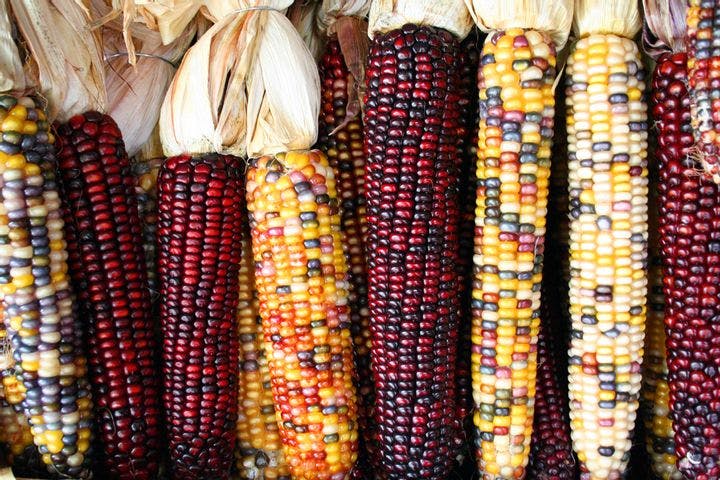Spring 2008
Bad Seeds
– Flora Lindsay-Herrera
Flora Linsay-Herrera reviews “Uncertain Peril,” which examines the brave new world of genetically modified foods and Doomsday seed vaults.
Recently, I attended a presentation at Cambridge University by an agricultural economist who sang the praises of biotech crops—genetically modified organisms (GMOs) engineered for traits ranging from insect resistance to herbicide tolerance. Several audience members recited the familiar objections to GMOs, which make up a majority of corn, soybean, and cotton crops in the United States: consumer health risks, poor crop performance, and the financial burden on farmers who must buy or license patented seed varieties every year. The economist shouted that his questioners were engaging in “subjective scaremongering and ranting.”
Sadly, this was a fairly typical exchange in the GMO wars. Though purportedly about matters of scientific fact—do these crops help or harm us and our environment?—the debate is dominated by the clash of mutually uncomprehending values and cultures. For every agricultural specialist extolling GMOs’ virtues, there is a Claire Hope Cummings, who alleges in Uncertain Peril that GMOs were “created by industry, for industry.”
Uncertain Peril joins the passel of books denouncing industrial agriculture for its role in “extinguishing agricultural diversity.” The plight of our seed supply was highlighted when the Global Seed Vault opened in Svalbard, Norway, in February. Of all the food crops humans have ever cultivated, more than 75 percent have disappeared, most in the last 100 years. Concern that we are losing seeds—perhaps with strains of resistance or other traits that will be vital in the future—prompted an internationally funded group called the Global Crop Diversity Trust to establish a “doomsday vault,” in which seeds from the world’s food plants can be stored for future retrieval in the event of a global calamity, such as climate change, or when war or natural disasters damage the holdings of regional seed banks (as recently occurred in Iraq).
Seed banks are useful, Cummings contends, but the principal solution to the loss of diversity is to encourage local seed saving and privilege farmers’ rights to develop locally adaptable crop varieties. Currently, she argues, those efforts are stymied by companies that market only a few crop varieties, and by the widespread practice of patenting seed genomes.
Cummings’s background in environmental law and journalism serves her well as she acquaints readers with the contours of the seed debates. But her activist bent is evident in her reduction of the issues to a two-dimensional standoff, and her slim bibliography in some cases simply refers readers to the general websites of groups such as “Organic Consumers Association” and “Genetic Resources Action International.”
Cummings’s biases are clear when, for example, she attacks Monsanto—one of the largest distributors of GMO seeds and a company often criticized for aggressively filing lawsuits against farmers it suspects of violating its seed patents—for monopolizing agribusiness. She bases her case primarily on the stories of a few farmers Monsanto sued, and on information provided by the Center for Food Safety, a nonprofit organization dedicated to “challenging harmful food production technologies and promoting sustainable alternatives.”
One of the strangest omissions in Uncertain Peril is any mention of Norman Borlaug, the Nobel Peace Prize–winning agronomist who introduced a high-yield wheat in the 1960s that was the forerunner of today’s more sophisticated biotech crops. Borlaug remains an iconic figure for GMO advocates (Monsanto recently donated $5 million to the Borlaug-founded World Food Prize for its “Borlaug Dialogue” program on global food security). He believed that better agricultural technology could help feed earth’s growing population, an argument that remains a cornerstone of agricultural biotech’s defense. Whatever Cummings thinks of his ideas, a thorough discussion of GMOs cannot leave them unaddressed.
After running through industrial agriculture’s dystopian fields, Cummings arrives at the hopeful paradise of GMO-free organic farming. She proposes promoting sustainable agriculture by renouncing our domination of nature and returning to the “cooperative reciprocal relationship” of pre-agribusiness days. Yet she poses a false choice between relying on the judgment of the “techno-elites” and using “our common sense and moral compass” to guide public policy. Yes, “stories can mend our broken world,” but only if they aspire to persuade—not drown out—opponents. Until scientists can engineer a second planet, biotechnology specialists and organic farmers must find a way to coexist on this one.
* * *
Flora Lindsay-Herrera is a former researcher at The Wilson Quarterly.
Reviewed: "Uncertain Peril: Genetic Engineering and the Future of Seeds" by Claire Hope Cummings, Beacon, 2007.
Photo courtesy of Wikimedia Commons
